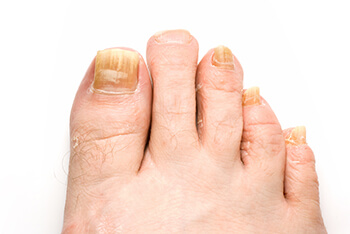Connect With Us
Fungus Toenails

Toenail fungus is a condition that many people develop and suffer from. Toenail fungus often results in the discoloration and thickening of the toenail, which can cause embarrassment for many people. The condition begins as a small white or yellow growth beneath the tip of the nail and at its worse can develop into the nail’s deterioration.
Fungal toenails form due to an infection that gets in between either the cracks in the nail or possible cuts on the surrounding skin. When this occurs, it’s likely to discolor and thicken the nail; this makes it hard to care for or trim. The nail itself may also become brittle and could potentially crumble. The fungus under the nail may build over time, separating the nail from the bed and ultimately causing it to fall off if not treated properly.
Fungal nails typically form due to the lack of footwear in public, warm, damp environments. Popular areas where patients have picked up a fungal infection include communal showers, locker rooms, gyms, and swimming pools. If you’re prone to sweaty feet, you may be more likely to develop a fungal nail as well. You may also be more likely to develop a fungal nail if you have a weaker immune system or have a history with athlete’s foot.
Toenail fungus can also be treated with certain over-the-counter antifungal creams and ointments. To remove pressure from the nails, keep them cut at a short length. Oral antifungal drugs, medicated nail cream, or medicated nail polish may also be prescribed by your podiatrist if simpler treatments do not prove successful. In some cases, your podiatrist may also recommend laser treatment to eradicate toenail fungus.
If you believe you’re experiencing a fungal toenail infection, we recommend that you speak with a podiatrist as soon as possible for a proper diagnosis and suggested plan for treatment.
REMY Laser Therapy
Available at East Ocean Podiatry, the Remy Laser is an innovative class IV laser used for treating chronic foot and ankle pain and toenail fungus. Treat your unique pain and/or be free of embarrassment from wearing open-toe shoes and sandals due to fungal nails.
Class IV laser therapy is one of the most safe and effective ways to treat various conditions that cause foot and ankle pain and toenail fungus (onychomycosis)! Laser therapy has a vast amount of benefits including:
- Accelerated cellular reproduction and growth – which is key in repairing the cells of cartilage, bone, tendons, ligaments, and muscle tissue.
- Reduced scar tissue that typically develops from specific injuries. When patients have less scar tissue, the likelihood of chronic pain is also reduced.
- Decreased inflammation and increased blood circulation.
- Penetration of the nail bed to kill fungus living underneath the nail - without pain and without any harmful side effects.
Laser therapy is a quick and easy treatment allowing patients to relax during the procedure.
Laser Therapy for Pain Management
With 26 bones in the foot alone, as well as major ligaments, tendons, joints, and nerves - it’s not surprising that millions of Americans suffer various types of foot and ankle pain.
Class IV laser therapy is used for the relief of pain, to accelerate healing and decrease inflammation.
When the light source is placed against the skin, photons penetrate several centimeters down and are absorbed by the mitochondria (the energy producing part of a cell). This energy results in the restoration of normal cell function.
The main goal of laser therapy is to stimulate the cell to perform its natural functions, but at an enhanced rate.
Laser therapy is a quick and easy treatment allowing patients to relax during the procedure. In contrast to “cold lasers,” which provide no feeling or sensation, high power diode laser therapy provides a warm, soothing feeling.
Some of the most common source of foot pain include:
- Plantar fasciitis – which often creates moderate to severe heel pain
- Tendonitis including
- Achilles tendonitis
- Posterior tendonitis (or PTTD)
- Peroneal tendonitis (tendonitis affecting the midfoot and arch)
- Ankle sprains
- Neuroma (or a pinched nerve)
- Arthritis and inflammation
- Bunions
- Hallux limitus (or a stiff big toe joint)
Any one of these conditions can create chronic (long-term) pain or acute (short-term) pain.
What is Onychomycosis?
Fungal foot infections. They can create major discomfort and even embarrassment. They are also EXTREMELY COMMON; affecting millions of people each year.
Additionally, fungus is easily spread. Individuals with fungus may have contracted it through shared bathroom space, public locker rooms, showers, and pools, shared clothing or shoes, even carpeting.
For some, fungus is simply genetic. When this is the case, treatment can become even more difficult given the likelihood of reoccurrence.
One of the most prevalent types of fungal foot infections directly affects your toenails. This type of condition is known as onychomycosis.
You may have onychomycosis if you notice any of the following symptoms:
- yellow or other discoloration of your toenails
- thickened or brittle toenails
- an unpleasant odor coming from the nail area
- pain
It’s not uncommon to feel discomfort and embarrassment due to the unsightly appearance and these symptoms of onychomycosis.
Fungal nail affects nearly 10% of the US population.
While many find the condition to be, simply, an eye sore, fungal nail can also lead to a larger problems incuding:
- infection of other toenails
- infecting friends and family
- increased pain
- ingrown toenails
Individuals with diabetes are also more susceptible to fungal nail given their compromised immune systems.
Laser therapy offers an effective, safe option for treating fungal toenail without the side effects of many oral medications.
